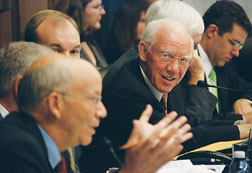 REP. James Oberstar Oberstar’s bill authorizes $2 billion over two years.
|
Oberstar has turned to a smaller Plan B, a bill to authorize an added $2 billion over two years for deficient bridges and set tougher standards for bridge inspections. The bill is starting to move: Oberstar’s panel approved it on Oct. 31. He expects floor action in early December.
Brian Deery, senior director of the Associated General Contractors’ highway and transportation division, is pleased to see the bill advancing. “Clearly bridge, and highway needs in general, are huge and any effort to address those needs is good news,” he says. When industry compares the bill to Oberstar’s original idea, its funding is disappointing.
But the bill’s prospects are brighter. It’s in line with the 2008 transportation appropriations bill the Senate approved Sept. 12 that includes a $1-billion boost for bridges from the Highway Trust Fund. Oberstar’s bill taps the general fund.
A Federal Highway Administration spokesman says the Bush administration hasn’t yet taken a position on the House panel bill, but adds, “There is little reason to believe that these additional funds will not suffer from the same politicization that has taken place with other elements of the highway program.”
The measure also focuses on inspection, requiring annual checks of deficient bridges on federal-aid roads. Some states now inspect certain bridges annually. Federal rules mandate inspections every two years on all federal-aid bridges.
Oberstar’s bill would expand training for bridge inspectors, require state inspection program chiefs to be licensed engineers and mandate that inspection team leaders be licensed engineers or have at least 10 years of inspection experience. The requirements would apply to those named after the U.S. Dept. of Transportation issues implementing regulations. Brian Pallasch, American Society of Civil Engineers’ government relations director, says his group strongly believes that inspectors’ experience is important. But he adds, “There needs to be, if you will, that engineer in charge.”
In addition, the measure would direct U.S. DOT to develop a “risk-based priority” system for replacing or repairing deficient federal-aid bridges.
It would bar a state from transferring federal bridge aid to other highway categories unless it shows U.S. DOT that it has no deficient federal aid bridges.Tony Kane, American Association of State Highway and Transportation Officials’ engineering and technical services director, praises Oberstar for focusing attention on infrastructure and providing funds. But he says the limit on bridge-fund transfers would be burdensome for state DOTs.
week after the Aug. 1 Minneapolis bridge collapse, House Transportation and Infrastructure Committee Chairman James Oberstar (D-Minn.) responded with a proposal to raise $25 billion to fix ailing bridges, through a fuel-tax hike. But Oberstar says his idea “ran into a buzz saw in the Senate,” and strong Bush administration opposition.
Post a comment to this article
Report Abusive Comment